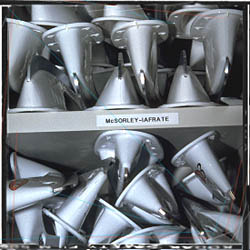|


|
Carbon-graphite sticks, aluminum shafts, and fiberglass/kevlar
goalie masks are a few of the technological advances that have changed hockey
gear, and consequently the game itself. In the game of hockey, the gear
is uniquely personalized and meticulously prepared. The gear, like the players
themselves, is placed in a hostile environment and receives a lot of abuse.
Players, equipment managers, and scientists talk about the sticks, skates,
pads, helmets, and other gear that help protect players and play a role
in the game itself.
In this section, there are RealAudio and video
clips from Sharks Equipment Manager Mike Aldrich, Exploratorium Scientist
Thomas Humphrey, Sharks defenseman Doug Bodger, and goalie Kelly Hrudey
.
|
|
The "Hollow-Grind"
Everyone knows that skate blades are made of steel. What
most people don't know is that the surface of the blade is not flat, but
concave. A process called hollow-grinding carves out the center steel in
a blade and produces two sharp edges. These edges give players the ability
to dig into the ice--to stop, start, or change direction.
|

|
Sharks Equipment Manager Mike Aldrich shows how to
sharpen a skate.
|
|
|
More on the "Hollow"
Each team's equipment manager is responsible for sharpening
the team's skates, and even the referees' skates during a home game. Sharks
equipment manager Mike Aldrich took us through the process. The skate--consists
of a boot, the blade holder, and a steel blade, with the holder attached
to the boot with rivets. Once the skate is assembled it is taken over to
the sharpener.
The sharpener has a rotating stone wheel that creates the
"hollow." The stone wheel itself is first shaped with a diamond
tip, then the skate blade is passed over the stone a couple of times to
identify the exact center point of the wheel. Once the center point is established,
the skate blade is passed over the wheel a number of times, each time becoming
smoother. A final pass is made with a light coat of oil to give the blade
a polish and to remove any excess debris. The skate then gets a couple of
passes with a hand stone and then it is wiped clean with a cloth.
Each player has his own personal preference as to how much
hollow he has in his skates. Goalies, for example, like less hollow in their
skates. This makes sense since they need to move quickly from side to side,
and a deeper hollow may cause an edge to catch in the ice. Each player also
has his own preference as to how often his skates are sharpened. Some players
may go a couple of games between sharpenings, while others may even request
that their skates are sharpened between periods. Occasionally, a player
will even change the depth of his hollow depending on ice conditions.
|
|

|
Doug Bodger explains what happens when a player loses
an edge
|
|
Losing an Edge
When these edges get dulled, players will sometimes have
their skates come out from under them. This phenomenon is called "losing
an edge." A variety of factors can contribute to losing an edge. Sometimes
the skate blade will come in contact with sand or dirt in the bench area
or with a goal post. Most commonly, the skate comes in contact with another
skate blade, during a collision or rough play near the boards. Players usually
don't realize their blade has been dulled until they try to make a sharp
turn or a stop and find themselves sprawled out on the ice.
|
|
Click the "forward"
button below to continue.
|

©
Exploratorium
|